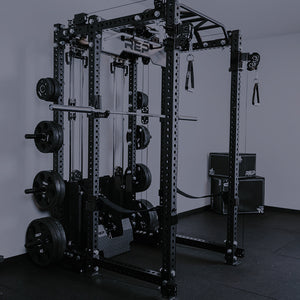
To max out or not to max out?
If you lift, you probably love to bench. And I'd wager you'd be over the moon if someone told you that benching your one rep max every day for a month could lead to massive strength gains.
Well friends, that day has arrived. A recent study published in the Journal of Exercise Physiology Online determined that participants who benched their 1 RM for 34 days saw a whopping 29% increase in strength.
However, before you swan dive onto that bench and kiss leg day goodbye, remember that anything that sounds too good to be true usually is. To get to the bottom of this flashy study, I asked fitness professionals what these bench press findings mean, if and how folks should apply it to their training, and to share any safety considerations to be aware of. Let's get into it.
Meet the experts
Davis Diley is a former ASC Professional Heavyweight Strongman, founder of the MYLIFT Training app, and all-around kick-ass athlete and strength trainer. He's got almost two decades of experience in powerlifting and bodybuilding—and you bet he's got opinions on how to hit chest day.
I also tapped Noah Tenenbaum, an MS in Applied Physiology and Kinesiology, CSCS, FMS-L1, FMS-YBT, FMS-FCS, and a REP product analyst. He's trained professional athletes and studied with some of the world's leading fitness researchers—including Dr. Mike Zourdos, the author of foundational research that inspired the very 1 RM bench press study we're examining here.
The study: Methods and findings
The method: Researchers had seven active individuals (three male and four female) bench press every day for 34 days. Each session involved determining participants' 1 rep max, followed by five sets of either three reps at 85% of that day's max or two reps at 90% of their 1 RM.
On day 35, participants did five sets of just one rep using 90–100% of their original max, and then rested for two days. On day 38, they tested their max bench press again to see how much they had improved compared to day one.
Other details to note: Participants in this study took 10g of creatine monohydrate daily, had caffeine before training sessions, and consumed 20g of protein post-workout.
The results: Everyone in the study got stronger. On average, their max bench press went up by about 41 pounds, or a roughly 29% increase. Men gained a bit more in total weight (+50 lbs) than women (+33.75 lbs), but both improved by nearly the same percentage.
Takeaways: Researchers found a strong link between the number of training days and strength gains, meaning the longer they stuck with the plan, the stronger they got. Overall, the study suggests that doing a daily max-effort bench press can be a fast and effective way to boost upper body strength for active men and women.

The big question: Should you bench for 1 RM every day?
Both of our experts agree: Probably not. While the study correlates a clear cause and effect, Diley thinks there's a better way to get the same gains while saving time and mitigating injury risk.
"Just because something worked and had a result does not mean it's the best way to get that result," he says. "Our goal should be to replicate [the outcome of this study] with as few training sessions as possible."
But why fewer sessions vs. every day? According to Diley, lifting heavy so frequently is more demanding on muscle tissues, which can impact recovery. Additionally, training muscles at a stretched or lengthened position—think about your pecs fully stretched at the bottom of a bench press — produces more tissue damage than training at shortened positions. The damage can acrue and lead to increased soreness, pain, and risk of injury.
In fact, participants of the 1 RM bench study all logged experiencing pain throughout the 34 days of training. So while, yes, strength training and muscle soreness go hand and hand, it could be much worse if you pursue daily 1 RM bench training.
Tenenbaum adds that anyone looking to pursue more 1 RM training should be careful not to exceed their Maximum Recoverable Volume. MRV is the max amount of training the body can handle while still recovering effectively. (Check out this video to figure out your MRV).
TL;DR— the study has legs, however (with a capital H), it's not the most effective or practical way to get strength gains. In fact, following this protocol may put you at risk of injury and lead to increased soreness or pain.
What are the risks of 1 RM training?
Simply put: Injury and overtraining. There's a lot at play when considering a 1 RM-focused training protocol—both good and bad. The main risk involves taxing muscles too frequently in a way that creates muscle damage and pain.
There's also always a baseline risk of injury when performing 1 RM training with heavy loads—whether from improper form, a simple mistake, or over-exertion. If you're not training with a coach or friend, it's important to take the proper precautions. Lock in on form, listen to your body, and make sure you have a set of safety bars or straps set up at the proper height.
You also don't want to just jump into benching your 1 RM. Diley recommends dedicating a few sessions to perfecting your bench technique with low frequency, volume, and reps. From there, you can work up to 1 RM training.
"Understand that it takes a long time to master a movement," says Diley. "Don’t look at something like this [study] as a quick fix. It demands respect. You can seriously hurt yourself if you try something this extreme too quickly."
Are there more effective ways to build strength?
Our experts say hell yes. Diley recommends keeping it simple with 2-3 strength sessions per week. Exercises should have 5-8 sets each and stick to the 3-8 rep range to target strength gains.
Tenenbaum adds to check your ego at the door.
"If it's too heavy, or something hurts, back off and lift within your abilities for that day. It is better to have a frustrating light day, than get injured," he says.
On a broader scale, Diley says it's imperitive to do your research and choose a fitness program that addresses your unique goals. From there, get your mind right and commit for at least 12-16 weeks.
"You have to start a program with belief. You shouldn't wait for it to prove itself to you," he says. "You are going to have awful-feeling training sessions. You will not perpetually get stronger. Get to the point where those ebbs and flows do not determine how you feel about the whole process. Develop faith and confidence in your programming so that even when you feel like crap, you know you're going to get stronger and it's worth it."

Strength gains vs. muscle gains: What's the difference and how do you train for them?
According to Tenenbaum, strength is the ability to apply or resist force. In the context of weightlifting, it's our capacity to lift heavy loads.
Muscle gains refers to the physical growth of muscle, both in overall mass (the quantity of muscle tissue cells) and size (how big the muscle tissue cells are).
While muscle mass certainly impacts strength, Diley points out that strength is a neurological adaptation and can be learned and perfected just like any other skill. The main difference in training for strength or muscle gains is proximity to failure.
Training for strength
Here's our best advice to train for strength:
- Each week, aim for 3-9 sets of 3-5 reps. You should divvy your 3-9 sets up among 2-3 training sessions. Your working sets should land around 1-4 reps. Don't come too close to failure.
- Be explosive—but with control. Lifting for strength requires power and speed. Breathe, brace, and hit that lift with intensity; you should not be flailing or flopping around like a fish.
- Don't let the bar or weight slow down too much. " If you’re grinding out slow reps at the end of every set, you’re training too close to failure," Diley says.
- Take 2-5 minutes of rest between sets. You should feel fully recovered before starting another set.
- Don't skip the warm up. Working with heavy loads requires building up to your working sets.
- Progress isn't always linear. While you should see consistent progress week over week, you may not lift heavier every single session. Be prepared for setbacks and don't push it just for the sake of outdoing your last lift. Stay healthy and play the long game.
Training to build muscle
Looking for muscle gains? Here's how to train for hypertrophy:
- Aim for 3-10 sets a week of 4-8 reps. Each set should come within 1 rep of failure.
- Build up to those working sets, but get there quicker. A strength-focused lift requires a longer warm-up period that you don't typically need when training for hypertrophy.
- Slow it down and grind it out. The goal is time under tension, not raw power.
- As always, lift safely with good form. Don't get sloppy halfway through the set. Stay calm, focused, controlled.
- Give yourself 2-5 minutes rest between sets. Start the next set when you've fully recovered. Not that bigger compound movements, like bench press, squats, or deadlifts, may require longer recovery time compared to isolation movements.
Davis Diley's tips for nailing the perfect bench press
The best lifters know: Technique and form are non-negotiables. Here's how Diley coaches the bench press.
- Prep and optimize. Develop strict consistency with your form before loading up the bar. Or, as Diley puts it, "Don't bench like an idiot."
- Set the safeties. 'Nuff said.
- Set your grip. Diley recommends a vertical grip with the hands and wrists stacked over the elbows. This positioning allows for greater range of motion.
- Stabilize: Upper body. Lay back on your bench. Pull the shoulders back and down, puff your chest out, allow for some arch, and lock everything in place.
- Stabilize: Lower body. Drive your feet down into the floor and push yourself up into the bench.
- Stabilize: Core. Connect the upper and lower body by bracing through your core. Breathe in and brace hard, like you're about to sneeze.
- Push the bar up and begin your lift. Your body should be "tightened like a bow ready to fire an arrow." Use that full-body tension to lower the bar down under control to just about chest level. Explosively push the bar back to the top of the movement.
- Rinse and repeat.
Takeaway
So what have we learned? Is this study viable: Yes. Is it right for the average Joe training at home: Maybe. Are there better training protocols: Definitely.
However you choose to hit bench day, make sure to listen to your body and move safely with good form. And if you give this 34-day 1 RM bench regimen a try, let us know how it goes.
FAQs
1 RM Calculator: How can I calculate my 1 RM?
A one rep max is the heaviest weight you can lift for a single repetition. If you're unsure what weight to attempt for a 1 RM, consider the heaviest weight you can lift for 3 reps. This is roughly 85-90% of your 1 RM.
When in doubt, try this handy calculator from NASM.
What muscles does the bench press work?
The bench press primarily works the following muscles:
- pectoralis major (chest)
- anterior deltoid (shoulders)
- triceps brachii (arms)
- biceps brachii (arms)
- serratus anterior (chest/torso)
Bench press workout
Want to put this all together? Check out this bench press guide, which goes over equipment, technique, modifications and variations.
Ashley Boyer is the Editor in Chief of REP Fitness. She's an ACE-CPT and master's candidate in Sports Performance and Conditioning at Southern Utah University. When not training for obstacle course races, you can find her hanging with her dogs or binging history documentaries.

NEWSLETTER SIGNUP
Product launch information, promotions, blogs, and REP news.







